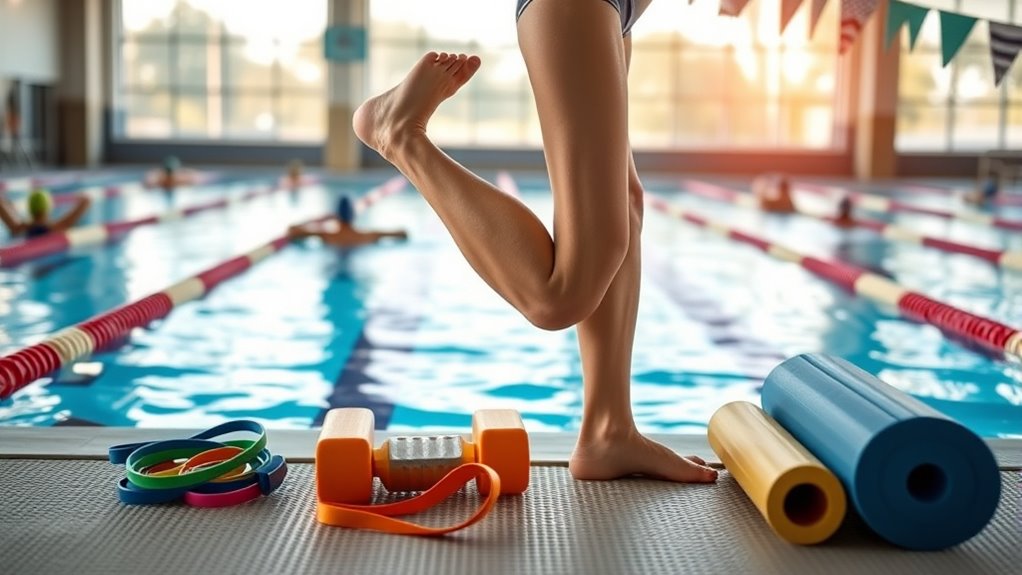To prevent cramps, start with gentle pre-swim mobility drills like neck rotations, shoulder circles, arm crosses, trunk twists, and hip circles. Add dynamic stretches such as leg swings and hamstring swings, along with walking lunges and side bends to loosen muscles and improve joint flexibility. Incorporate light cardio to raise your heart rate and promote circulation. Doing these exercises regularly can help keep muscles loose and ready—keep going to learn even more effective warm-up techniques.
Key Takeaways
- Incorporate dynamic stretches like leg swings and arm crosses to improve muscle elasticity and blood flow before swimming.
- Perform joint mobility exercises such as shoulder circles and ankle rotations to enhance flexibility and reduce cramp risk.
- Use controlled breathing techniques during warm-up to promote relaxation and optimal oxygen delivery to muscles.
- Engage in light cardio, like brisk walking or jumping jacks, to elevate heart rate and prepare muscles for activity.
- Focus on gradual, gentle movements to prevent overstretching and muscle strain, supporting overall cramp prevention.
Gentle Neck Rotations
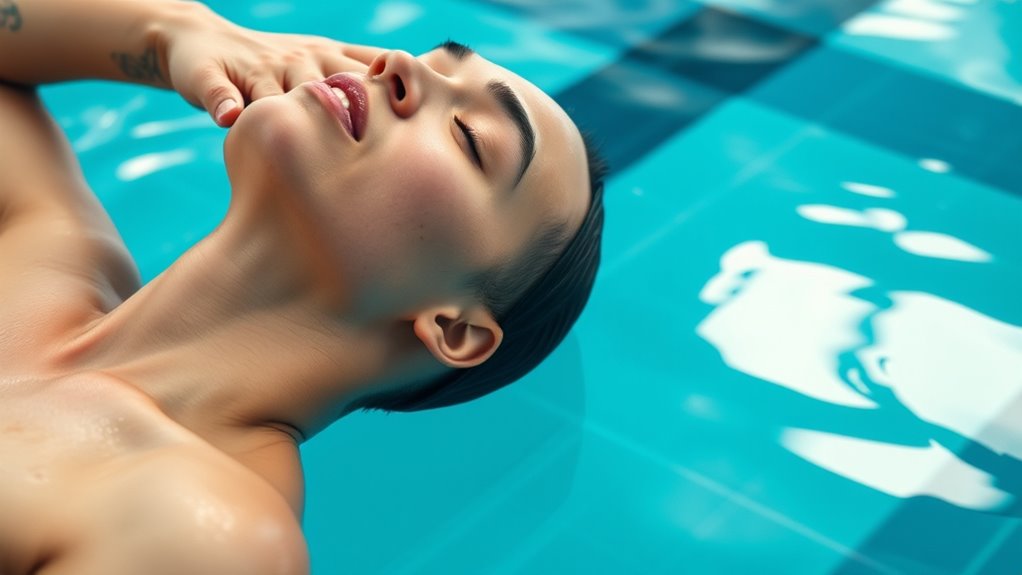
Begin your pre-swim routine with gentle neck rotations to loosen up the muscles and increase flexibility. This simple move helps release neck tension that can restrict cervical mobility and cause discomfort during your swim. Stand or sit tall, keep your shoulders relaxed, and slowly turn your head to one side, then the other. Maintain a smooth, controlled motion, avoiding any jerking or overextension. These rotations improve neck flexibility, reduce stiffness, and prepare your cervical muscles for the movement demands of swimming. Incorporating mindful movement into your routine can further support physical awareness and reduce the risk of injury. Engaging in proper warm-up techniques before swimming can also enhance your muscle readiness and prevent cramps. Regularly practicing gentle neck rotations can prevent tightness and help you maintain proper alignment, ultimately enhancing your overall comfort and performance in the water. Paying attention to muscle readiness during warm-ups can optimize your overall preparation and help prevent cramping. Additionally, understanding AI safety measures in training environments can support safer, more effective warm-up routines. Keep the movements gentle, focused, and consistent for the best results.
Shoulder Circles and Rolls

Shoulder circles and rolls are great ways to improve your shoulder mobility and keep muscles loose. These movements help prevent tightness that can limit your swim performance. Incorporate them into your warm-up to stay flexible and ready to move freely. Additionally, proper muscle flexibility through targeted mobility exercises can enhance overall athletic performance and reduce injury risk. Regular mobility drills can also help alleviate muscle tension and promote better circulation in the shoulder region. Engaging in these exercises consistently is essential for maintaining optimal flexibility and ensuring your muscles stay resilient during intense activities.
Improve Shoulder Mobility
Have you ever noticed how stiff shoulders can hinder your swimming performance? Improving shoulder mobility is key to better movement and injury prevention. Start with shoulder circles and rolls to loosen up the joint and enhance shoulder joint stability. These simple movements help increase flexibility and prepare your muscles for the swim. To further support shoulder health, incorporate rotator cuff exercises that strengthen the muscles around the joint, promoting stability during intense strokes. Better shoulder mobility allows for a more efficient, pain-free stroke, reducing the risk of cramps and strains. Incorporating joint stability exercises can also help maintain proper shoulder mechanics during swimming. Understanding narcissistic traits can also help you recognize and manage your own responses to perceived threats or criticisms during training, fostering a healthier mental approach. Incorporating adaptive exercises can further improve mobility and prevent stiffness over time. Consistently practicing these drills before your swim ensures your shoulders move freely and comfortably, setting a solid foundation for improved technique and endurance in the water. Additionally, considering the importance of proper technique can help prevent overuse injuries and enhance overall performance.
Prevent Muscle Tightness
To prevent muscle tightness that can limit your swimming efficiency, incorporating simple shoulder circles and rolls into your warm-up routine is highly effective. These movements help loosen tight muscles, reducing the risk of cramps caused by muscle fatigue. Regularly moving your shoulders through full ranges of motion improves flexibility and circulation. Additionally, using proper calibration techniques can help ensure your body is ready for optimal movement and reduce strain. Proper muscle preparation also enhances overall performance and prevents injuries. Remember, hydration strategies are vital—staying well-hydrated helps prevent muscle cramps and tightness. Dehydration can lead to muscle fatigue, increasing the chance of tightness during your swim. Incorporating natural materials like linen or breathable fabrics in your workout clothing can improve comfort and moisture-wicking, aiding in hydration and temperature regulation. Being mindful of hydration is essential for maintaining electrolyte balance and preventing cramps. By combining shoulder circles and rolls with proper hydration, you prepare your muscles for activity, promote better blood flow, and minimize tightness. Consistent prep like this ensures your shoulders stay loose, allowing for smoother, more comfortable swimming and reducing the risk of cramps caused by muscle tightness.
Arm Crosses for Shoulder Flexibility
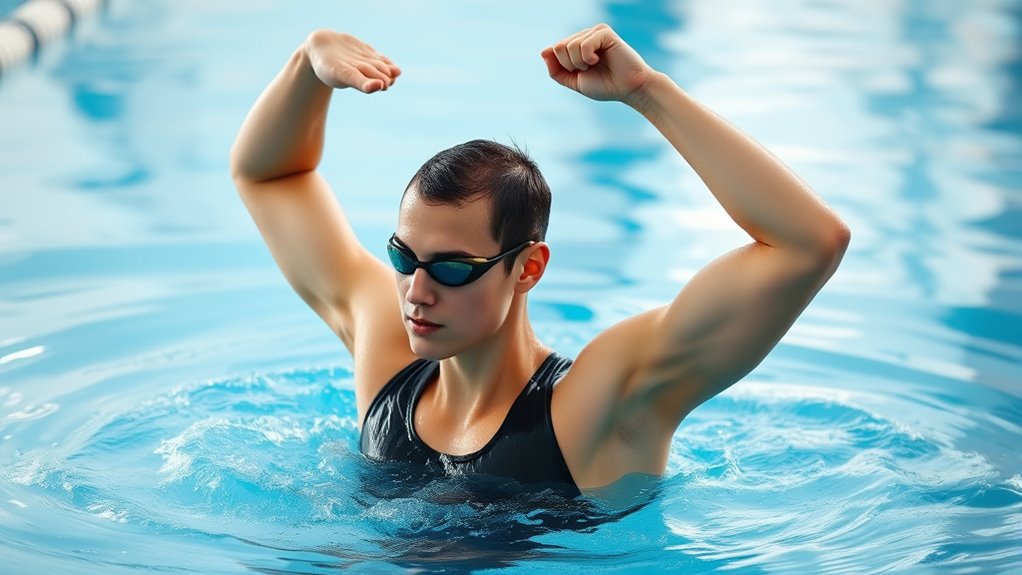
Arm crosses are a simple yet effective way to enhance shoulder flexibility before swimming. By performing arm crosses, you stretch the shoulder muscles and improve their range of motion, which helps prevent cramps during your swim. To do this, stand tall and extend your arms straight in front of you. Cross one arm over the other at shoulder height, then gently pull the top arm closer to your chest with your opposite hand. Hold for a few seconds, then switch arms. Repeating this motion increases shoulder mobility and reduces stiffness, making your swimming smoother and more comfortable. Incorporating arm crosses into your pre-swim routine prepares your shoulders for the demands of swimming, helping you move more freely and reducing the risk of cramps caused by tight muscles. shoulder flexibility is essential for a comfortable and injury-free swimming experience. Regularly practicing these drills can also contribute to better overall shoulder health and performance. Additionally, using crochet tools for creative exercises can make your warm-up more engaging and effective.
Trunk Twists to Loosen the Spine
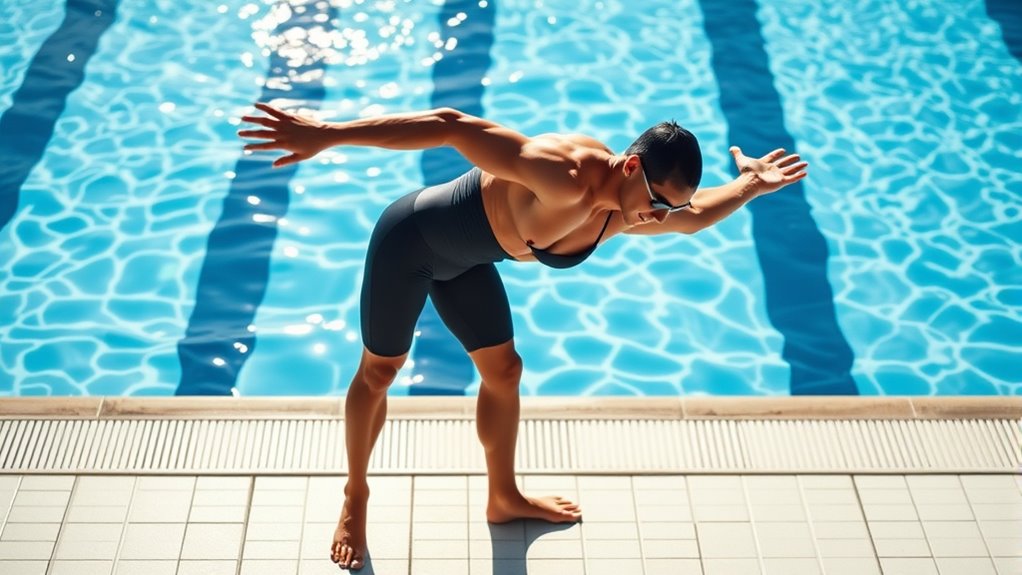
Trunk twists activate your core muscles while loosening your spine, preparing your body for swimming. As you twist side to side, you’ll notice improved spinal flexibility and a greater range of motion. These simple movements set the foundation for a more efficient and comfortable swim.
Engage Core Muscles
Engaging your core muscles through trunk twists can effectively loosen your spine before swimming. This movement promotes core activation and abdominal engagement, which helps stabilize your torso and improve overall mobility. To maximize benefits, focus on controlled movements that engage your abs and obliques. Incorporating aesthetic wall organization techniques can also keep your workout space tidy and motivating. Additionally, maintaining a clean and organized environment can enhance your focus and air quality, contributing to a more effective exercise session. Recognizing the importance of spiritual guidance can also motivate discipline in your warm-up routine. Embracing a mindset that values failure as a learning opportunity can further encourage perseverance and resilience during your exercises.
Improve Spinal Flexibility
To enhance your spinal flexibility before swimming, trunk twists are a highly effective and simple exercise. They help improve posture correction by promoting better spinal alignment, which is essential for efficient movement in the water. Stand with your feet shoulder-width apart, place your hands on your hips or extend your arms, and gently rotate your upper body from side to side. Focus on keeping your hips stable as your spine twists naturally. This movement loosens tight muscles along your back and encourages a more flexible, aligned spine. Regularly practicing trunk twists before your swim can reduce stiffness and improve your overall mobility, making your strokes smoother and more efficient. Incorporate this exercise into your warm-up routine for best results.
Enhance Range of Motion
Enhancing your range of motion in the spine is essential for smooth, efficient swimming. Trunk twists help loosen the spine and improve muscle elasticity, making your movements more fluid. As you perform these twists, you promote joint lubrication, which reduces stiffness and enhances mobility. Focus on controlled, deliberate rotations, keeping your hips stable while twisting your upper body from side to side. This drill increases flexibility in the thoracic spine, allowing for better reach and rotation during strokes. Improved joint lubrication ensures your spinal joints move smoothly, preventing tightness that can lead to cramps. Additionally, understanding Glycolic Acid Benefits for Skin can inform innovative ways to incorporate technology into training routines and optimize athletic performance. Incorporate trunk twists into your pre-swim routine to maximize spinal flexibility, boost muscle elasticity, and prepare your body for ideal performance in the water.
Hip Circles and Leg Swings

Hip circles and leg swings are essential movements to loosen up your hips and prepare your body for swimming. These exercises target hip mobility, helping you move your hips more freely and efficiently. By performing hip circles, you activate the muscles around your pelvis, reducing stiffness and improving joint range of motion. Leg swings enhance leg flexibility, warming up your hip flexors, hamstrings, and glutes. As you swing your legs forward, backward, and side to side, you increase blood flow and prepare your muscles for the dynamic movements of swimming. Incorporating these drills into your pre-swim routine helps prevent cramps by ensuring your hips are mobile and your leg muscles are ready to perform. Consistent practice improves overall mobility, making your swim smoother and more comfortable.
Ankle Rotations and Calf Stretches
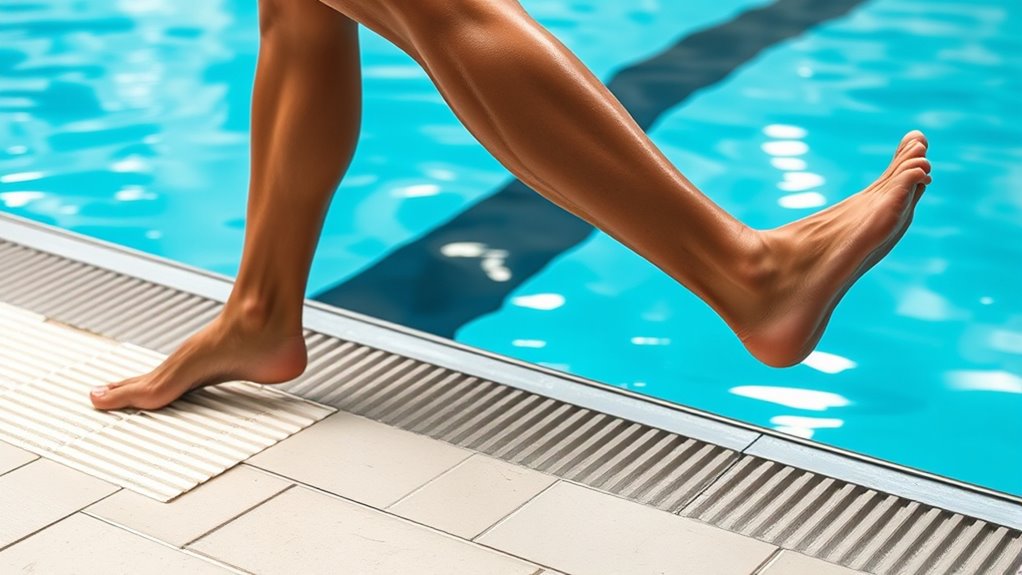
After loosening your hips with leg swings, focusing on your ankles and calves helps complete your warm-up. Start with ankle rotations by lifting one foot and rotating your ankle clockwise and counterclockwise for 10-15 seconds each way. Switch feet and repeat. This activates your ankle joints, improving mobility and reducing cramp risk. Next, perform calf stretches by placing your hands against a wall, stepping one foot back, and pressing the heel into the ground. Keep your back leg straight and bend the front knee slightly, feeling the stretch in your calf. Hold for 20-30 seconds, then switch legs. These ankle rotations and calf stretches enhance blood flow, loosen tight muscles, and prepare your lower legs for swimming, helping prevent cramps during your workout.
Dynamic Hamstring Stretches

Dynamic hamstring stretches are an effective way to increase flexibility and blood flow to your legs before swimming. These stretches help improve muscle elasticity, making your hamstrings more responsive and less prone to cramps. To perform them, stand with your feet hip-width apart and swing one leg forward and back, keeping it straight. Focus on controlled movements and gradually increase your range of motion. Switch legs and repeat for 10-15 swings each side. Dynamic hamstring stretches activate the muscles, prepping them for physical activity. They also enhance circulation, reducing the risk of muscle tightness during your swim. Incorporating these stretches into your warm-up routine ensures your hamstrings are ready for the demands of swimming, promoting better performance and minimizing cramp potential.
Walking Lunges With Torso Twists
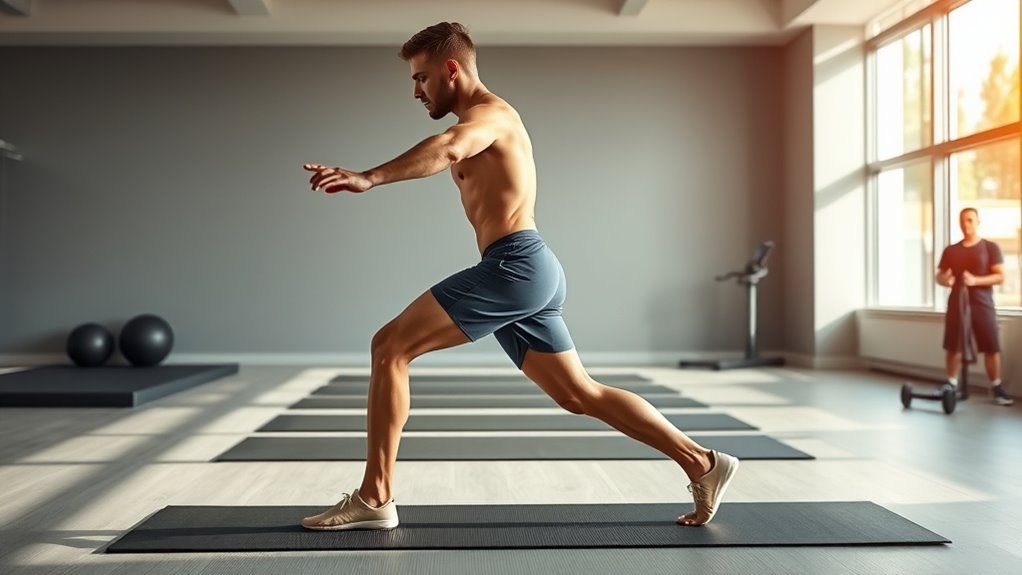
Building on your hamstring stretches, incorporating walking lunges with torso twists further prepares your lower body and core for swimming. As you perform each lunge, engage your leg muscles to mimic the push-off needed for powerful swimming strokes. The torso twists activate your obliques and improve rotational mobility, essential for efficient strokes like freestyle and butterfly. This drill also enhances your balance and stability, which are vital for smooth pool entry techniques and maintaining proper form in the water. Moving forward with controlled steps, focus on deep, steady breaths to simulate breathing patterns during swimming. Regularly practicing walking lunges with torso twists helps prevent cramps by warming up muscles and increasing flexibility, ensuring you enter the pool ready to perform your best across all strokes.
Side Bends and Lateral Stretches
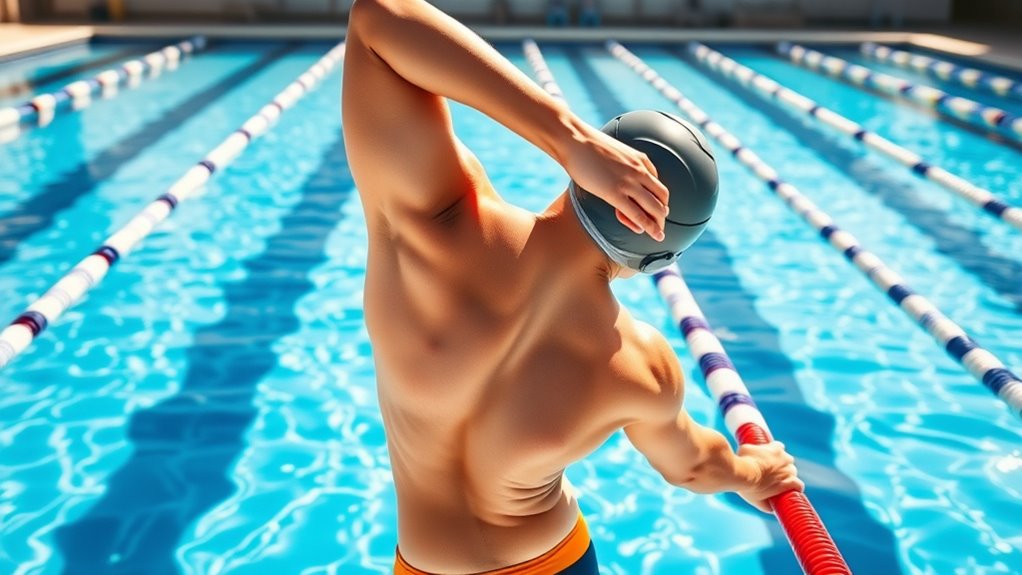
Side bends and lateral stretches are simple moves that improve your spinal flexibility and help prevent stiffness before swimming. You’ll feel your muscles loosen up, making your body more agile in the water. Incorporating these stretches can boost your overall mobility and reduce the risk of injury.
Enhances Spinal Flexibility
To improve your spinal flexibility, incorporating side bends and lateral stretches into your pre-swim routine can be highly effective. These stretches promote spinal extension and increase vertebral mobility, essential for smooth, efficient movements in the water. As you bend sideways, you stretch the muscles along your spine, helping to loosen tightness and improve range of motion. Lateral stretches target the sides of your torso, encouraging flexibility in your vertebral joints. Maintaining this flexibility can reduce stiffness and enhance your overall swimming posture. Regularly practicing these stretches before your swim ensures your spine is prepared for the dynamic movements ahead. Ultimately, increased spinal flexibility helps you move more freely and comfortably, reducing the risk of cramps caused by restricted motion or muscle tightness.
Reduces Muscle Stiffness
Performing side bends and lateral stretches before swimming helps loosen tight muscles, reducing stiffness that can hinder your range of motion. This increased flexibility supports better muscle recovery after your workout, minimizing soreness and preventing cramps. These stretches also enhance blood flow, which is essential for ideal hydration tips and nutrient delivery to muscles. Incorporating these drills into your warm-up routine ensures your muscles stay supple and prepared for activity.
Consider these points for maximizing benefits:
- Maintain proper hydration to enhance muscle elasticity
- Incorporate gentle, controlled movements to avoid overstretching
- Focus on breathing deeply to promote relaxation and blood circulation
Light Cardio to Elevate Heart Rate
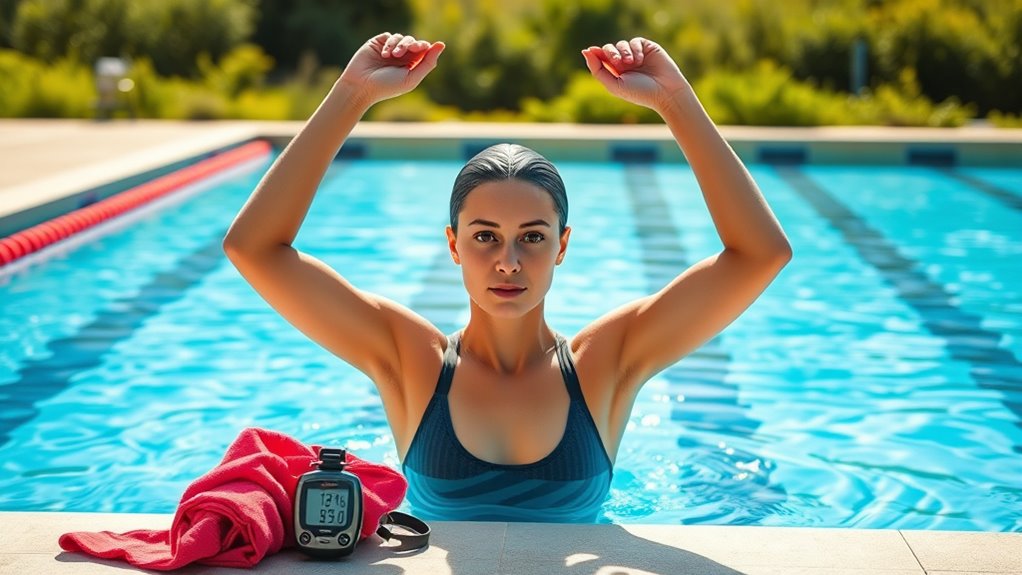
Before diving into more intense swimming drills, it’s important to get your blood flowing with some light cardio. This helps elevate your heart rate and prepares your body for activity. As you do this, focus on breathing techniques to maintain a steady rhythm, ensuring your oxygen intake supports your muscles and mind. Keeping your mental focus sharp during this warm-up helps prevent distractions that could lead to cramps later. Simple activities like brisk walking, jumping jacks, or cycling are effective. They warm your muscles, increase circulation, and boost your energy levels. Remember, this light cardio isn’t about exhaustion but about gradually priming your body. With controlled breathing and mental focus, you’ll set a solid foundation for a safer, more effective swim.
Frequently Asked Questions
How Long Should Each Pre-Swim Mobility Drill Last?
For your pre-swim mobility drills, aim for a duration of about 5 to 10 minutes, following the most effective timing guidelines. This allows your muscles to warm up properly without causing fatigue. Focus on dynamic stretches and gentle movements that target key muscle groups used in swimming. Keep the drills moderate in length so you stay energized and ready for your swim, helping to prevent cramps and improve performance.
Are These Drills Suitable for All Age Groups?
Ever wonder if mobility drills are suitable for everyone? You’ll find that most pre-swim mobility drills are adaptable, making them age-appropriate and beneficial for senior fitness. However, it’s essential to contemplate individual health and mobility levels. Are you incorporating these drills to prevent cramps and improve flexibility? Adjust the intensity and duration as needed, ensuring all age groups can safely participate and enjoy the benefits of better movement and reduced injury risk.
Can These Exercises Be Performed Before Any Type of Swim Stroke?
You can perform these exercises before any swim stroke, as they serve as effective stroke-specific warmups and aquatic flexibility exercises. These drills prepare your muscles, improve joint mobility, and reduce cramps, no matter which stroke you choose. Incorporate them into your routine to enhance performance and prevent injury. Just make certain you adapt the intensity based on your skill level and comfort, making them versatile for all swim styles.
How Often Should I Incorporate Pre-Swim Mobility Drills Into My Routine?
Think of your body as a finely tuned engine—regular maintenance keeps it running smoothly. You should incorporate pre-swim mobility drills about 3-4 times a week, like tuning the engine before each long drive. This frequency helps you plan injury prevention and prepares your muscles for action. Consistent use guarantees your muscles stay limber, reducing cramps and enhancing performance, turning each swim into a seamless, effortless glide through the water.
Are There Any Signs Indicating I Should Skip These Warm-Up Exercises?
If you notice signs of fatigue or muscle pain before your swim, you might consider skipping your warm-up exercises. These signals indicate your body needs rest rather than activity, and forcing a warm-up could worsen discomfort or increase injury risk. Always listen to your body, and if symptoms persist, it’s better to delay your swim or adjust your warm-up routine. Prioritize recovery to stay safe and improve performance.
Conclusion
By doing these simple mobility drills, you’re transforming your pre-swim routine into a superhero’s warm-up. Imagine your muscles waking up like a sunrise, ready to leap into action without a single cramp daring to show its face. With each gentle rotation and stretch, you’re building an unstoppable fortress against cramps—keeping your body flowing like a perfectly tuned engine. Plunge into, loosen up, and feel invincible in the water!

